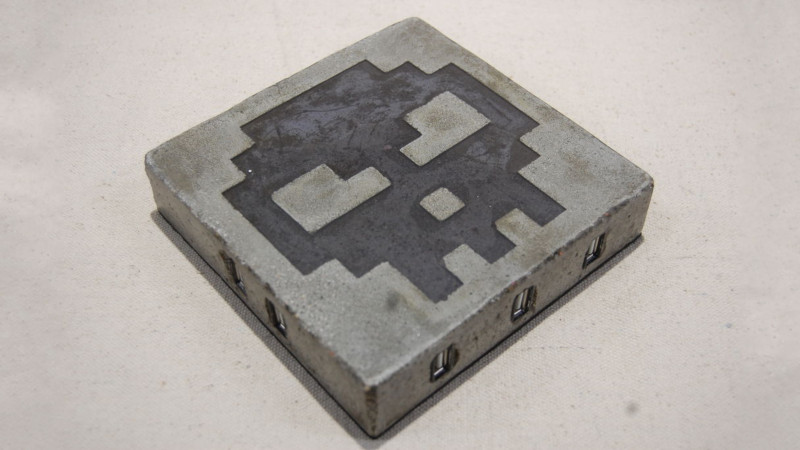When starting a new project, the choice of material can have a big effect on the character of the finished product. Wood is stylish and has a certain elegance to it, while polished or brushed aluminium is great for a more futuristic feel. Sometimes though, you just want big, cheap and heavy – in which case, concrete is your friend!
[BALES] was short on USB ports, and needed a hub with plenty of connectivity. Concrete had the benefits of being solid and heavy, and also impervious to beverages. Thus, a melamine form was produced, chosen as its surface doesn’t give the concrete anything to grab on to. A foam skull was cut out and added to create an inlay for decoration, and the 7-port octopus-style hub was placed inside.
With careful attention paid to the mixture consistency, the concrete was poured into the mold and allowed to set. Care was taken to avoid air bubbles and to ensure the mixture flowed completely into the mold, without leaving air pockets behind the inserted components. After allowing it to set for a few days, the part was demolded, with care taken to minimise edge crumbling. The foam skull was removed, and infilled with black epoxy, with a little more used to coat the top and sides of the hub. As a finishing touch, a foam pad was fitted to the base to allow it to sit on a desk without scratching everything up.
In the end, [BALES] has ended up with a hefty hub that won’t skitter around when plugging and unplugging devices. It should also serve admirably as a sturdy drink coaster on those cold winter nights. If you’re trying a similar project yourself, note that sometimes concrete can be surprisingly conductive. Video after the break.















Maybe do a conformal coating before the concrete layer?
What a brute. I would rather use few screws and mount it anywhere than to sink it in concrete.
My only concern would be the reaction between the concrete and the metal in the hub. The plastic case should mitigate most if not all of that, but time will tell how long it lasts.
I love the idea. Now to incorporate a coffee cup warmer in to the top of it. hmmmm
Thanks. Inspired the though of a TEMPEST desktop/server build similar in line with the mini-lathe beds using epoxy and granite.
Seems other materials in the cement mix that can shield from emissions can also benefit the system maybe even with closed looped heat exchanging also for a more passive design.
Wondering about ions I guess causing corrosion also… though seems an inner liner integrated with the cover using maybe tapered shanked rims lined with a polymer coating will mitigate that risk.
Neat build… cement is an interesting material to work with. Especially when you can visualize layering with other materials to enhance performance.
Not to be picky but that looks like he just used cement, probably Portland cement and not concrete. Not that there is anything wrong with that in this application at all. Concrete would have had sand and gravel in the mix which is where it gets its strength. Nice project though, it looks good and probably no one will steal it because it is too heavy, ha ha.
Reminds me of this one
https://hackaday.com/2016/12/03/thwomp-drops-brick-on-retro-gaming/
I discovered this guy last night, The CrafsMan He has the coolest introduction to concrete ever:
https://youtu.be/TzVA5bWVUqA
This looks awesome! Nice work.
What about thermal resistance? I know USB hubs which get pretty warm… putting them into cement (or concrete) could actually kill the chips inside…